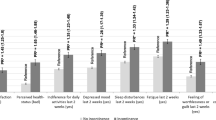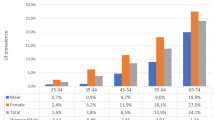Abstract
The purpose of this study was to evaluate the prevalence of urinary incontinence (UI) in a Korean national community sample of female adults aged 30–79 years. During April 2003, a national Korea telephone survey using quota sampling methods was conducted. The clinically validated computer-assisted telephone interview approach was used in the survey. Of the 1,500 subjects contacted, 1,303 were successfully interviewed (response rate 86.9%). Overall, UI was reported by 40.8%, and 22.9, 3.1, and 14.9% reported pure stress, urge, and mixed UI, respectively. The prevalence of stress, urge, and mixed UI generally did not increase with age. Urge and mixed UI had a greater impact than stress UI on daily tasks (P < 0.001), social life (P < 0.001), depression or anxiety due to UI (P < 0.001), worry about UI (P < 0.001), sex life (P < 0.001), wear protection due to UI (P = 0.011), and quality of life (P < 0.001). In subjects with pure stress UI, 28.3% reported impaired quality of life compared with 43.9% and 43.8% of subjects with urge and mixed UI. Of those individuals with stress, urge, and mixed UI, 19.1, 20.0, and 25.8% had the willingness to seek medical consultation. This study is the first to examine the prevalence of UI in Korean women. The present study revealed that there was a high prevalence of UI in this population. Our descriptive research provides a valuable insight into the need for tailored education to this population about UI.
Similar content being viewed by others
References
Abrams P, Cardozo L, Fall M et al (2002) The standardization of terminology of lower urinary tract function: report from the standardization sub-committee of the International Continence Society. Neurourol Urodyn 21:167–178
Norton P, Brubaker L (2006) Urinary incontinence in women. Lancet 367:57–67
Thom DH, van den Eeden SK, Ragins AI et al (2006) Differences in prevalence of urinary incontinence by race/ethnicity. J Urol 175:259–264
Hsieh CH, Su TH, Chang ST (2005) Prevalence of and attitude toward urinary incontinence in Taiwanese women. Int J Gynecol Obstet 88:152–153
Araki I, Beppu M, Kajiwara M et al (2005) Prevalence and impact on generic quality of life of urinary incontinence in Japanese working women: assessment by ICI questionnaire and SF-36 Health Survey. Urology 66:88–93
Chen GD, Lin TL, Hu SW et al (2003) Prevalence and correlation of urinary incontinence and overactive bladder in Taiwanese women. Neurourol Urodyn 22:109–117
Hannestad YS, Rortveit G, Sandvik H, Hunskaar S (2000) A community-based epidemiological survey of female urinary incontinence: the Norwegian EPINCONT study. Epidemiology of incontinence in the county of Nord-Trondelag. J Clin Epidemiol 53:1150–1157
Brieger GM, Yip SK, Chung TK (1996) The prevalence of urinary dysfunction in Hong Kong Chinese women. Obstet Gynecol 88:1041–1044
Breiger GM, Mongelli M, Hin LY, Chung TK (1997) The epidemiology of urinary dysfunction in Chinese women. Int Urogynecol J Pelvic Floor Dysfunct 8:191–195
Kelsey JL, Whittemore AS, Evans AS, Douglas TW (1996) Methods in observed epidemiology, 2nd edn. Oxford University Press, New York, pp 311–40
Gross PA, Wagner T, Hu TW (1998) Economic costs of urinary incontinence in 1995. Urology 51:355–361
Brocklehurst JC (1993) Urinary incontinence in the community—analysis of a MORI poll. BMJ 306:832–834
McGrother C, Donaldson M, Heywood T (2003) Urinary incontinence and storage symptoms: prevalence, impact and need for services in the UK 1960–2001—a systematic review. ICS International Conference, Florence
Kuh D, Cardozo L, Hardy R (1999) Urinary incontinence in middle aged women: childhood enuresis and other lifetime risk factors in a British prospective cohort. J Epidemiol Community Health 53:453–458
Harrison GL, Memel DS (1994) Urinary incontinence in women: its prevalence and its management in a health promotion clinic. Br J Gen Pract 44:149–152
Nygaard IE, Lemke JH (1996) Urinary incontinence in rural older women: prevalence, incidence and remission. J Am Geriatr Soc 44:1049–1054
Björnsdóttir LT, Geirsson RT, Jónsson PV (1998) Urinary incontinence and urinary tract infections in octogenarian women. Acta Obstet Gynecol Scand 77:105–109
Milsom I, Abrams P, Cardozo L, Roberts RG, Thuroff J, Wein AJ (2001) How widespread are the symptoms of an overactive bladder and how are they managed? A population-based prevalence study. BJU Int 87:760–766
Lapitan MC, Chye PL, Asia-Pacific Advisory Board (2001) The epidemiology of overactive bladder among females in Asia: a questionnaire survey. Int Urogynecol J Pelvic Floor Dysfunct 12:226–231
Simeonova Z, Milsom I, Kullendorff AM, Molander U, Bengtsson C (1999) The prevalence of urinary incontinence and its influence on the quality of life in women from an urban Swedish population. Acta Obstet Gynecol Scand 78:546–551
Elving LB, Foldspang A, Lam GW, Mommsen S (1989) Descriptive epidemiology of urinary incontinence in 3,100 women age 30–59. Scand J Urol Nephrol Suppl 125:37–43
Moller LA, Lose G, Jorgensen T (2000) The prevalence and bothersomeness of lower urinary tract symptoms in women 40–60 years of age. Acta Obstet Gynecol Scand 79:298–305
Fultz NH, Burgio K, Diokno AC et al (2003) Burden of stress urinary incontinence for community-dwelling women. Am J Obstet Gynecol 189:1275–1282
Nygaard I, Turvey C, Burns TL, Crischilles E, Wallace R (2003) Urinary incontinence and depression in middle-aged United States women. Obstet Gynecol 101:149–156
Robinson D, Pearce K, Preiser J et al (1998) Relationship between patient reports of urinary incontinence symptoms and quality of life measure. Obstet Gynecol 91:224–228
Coyne KS, Zhou Z, Thompson C, Versi E (2003) The impact on health-related quality of life of stress, urge and mixed urinary incontinence. BJU Int 92:731–735
Stewart WF, Van Rooyen JB, Cundiff GW et al (2003) Prevalence and burden of overactive bladder in the United States. World J Urol 20:327–336
Brown JS, Subak LL, Gras J, Brown BA, Kuppermann M, Posner SF (1998) Urge incontinence: the patient’s perspective. J Womens Health 7:1263–1269
Lenderking WR, Nackley JF, Anderson RB, Testa MA (1996) A review of the quality-of-life aspects of urinary urge incontinence. Pharmacoeconomics 9:11–23
Yu HJ, Wong WY, Chen J et al (2003) Quality of life impact and treatment seeking of Chinese women with urinary incontinence. Qual Life Res 12:327–333
Reymert J, Hunskaar S (1994) Why do only a minority of perimenopausal women with urinary incontinence consult a doctor? Scand J Prim Health Care 12:180–183
Mitteness LS (1990) Knowledge and beliefs about urinary incontinence and adulthood and old age. J Am Geriatr Soc 38:374–378
Jeter KF, Wagner DB (1990) Incontinence in the American home: a survey of 36,500 people. J Am Geriatr Soc 38:379–383
Roe B, Doll H, Wilson K (1999) Help seeking behaviour and health and social services utilisation by people suffering from urinary incontinence. Int J Nurs Stud 36:245–253
Oh SJ, Hong SK, Son H, Paick JS, Ku JH (2005) Quality of life and disease severity in Korean women with stress urinary incontinence. Urology 66:69–73
Coutts LC, Hardy LK (1985) Teaching for health. Churchill Livingstone, Edinburgh
Button D, Roe B, Webb C, Frith T, Colin Thome D, Gardner L (1998) Continence promotion and management by the primary health care team: consensus guidelines. Whurr, London
Acknowledgment
This study was supported by the Korean Continence Society.
Author information
Authors and Affiliations
Corresponding author
Rights and permissions
About this article
Cite this article
Choo, MS., Ku, J.H., Oh, SJ. et al. Prevalence of urinary incontinence in Korean women:an epidemiologic survey. Int Urogynecol J 18, 1309–1315 (2007). https://doi.org/10.1007/s00192-007-0322-z
Received:
Accepted:
Published:
Issue Date:
DOI: https://doi.org/10.1007/s00192-007-0322-z




